Positive Updates Regarding Physical Therapy For SMA Patients

As mentioned in our previous article, Michael, our patient with SMA, had been suffering from tailbone pain that was subsided by a modified stuck drawer technique to his sacrum. We had initially intended on performing this every other week, but since Michael has been having no complaints of pain, we have pushed this to once a month. If he’s still pain-free at the end of the four-week period, we will push it to six weeks and see how long the technique leaves him pain-free.
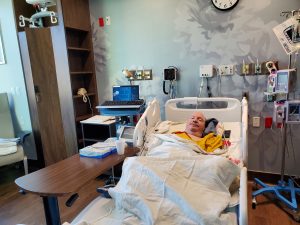

Another topic recently discussed has been the increased chance of kidney stones in people who are limited in their mobility for many different reasons. We mentioned that one very important thing to monitor is fluid intake and staying hydrated to reduce this risk. Since Michael’s last surgery to break up the kidney stones, he has increased his fluid intake to keep himself hydrated as instructed by his doctors. This should, in turn, reduce the risk of developing more kidney stones in the future. Michael did tell us that kidney stones are fairly common in people who have SMA. Because of Micael’s sedentary lifestyle, and his lack of ambulatory motions, this is probably going to be an ongoing issue for the rest of his life.
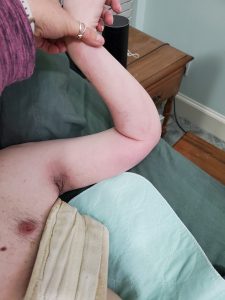
In Michael’s lifetime, he’s had a total of five kidney surgeries, but his most recent surgery caused him to become extremely anemic, due to the amount of blood loss. When he went back to the hospital, a blood test revealed a dangerously low sugar count, so they gave him an intravenous infusion of saline and dextrose. The day after his IV infusion, Michael’s left arm and bicep became swollen and sore, so he went back to the hospital. Immediately, doctors ordered a sonogram of Michael’s left side and extremities, and the sonogram revealed four blood clots in his left bicep. Two of these blood clots were classified as deep tissue DVTs, and two of them were classified as superficial DVTs. His doctors put him on Xarelto, which is a blood thinner that is commonly used to dissolve blood clots. Michael is scheduled to go back to the hospital in one week for a follow-up sonogram to make sure that these blood clots are dissolving properly. It is also important to make sure he is going in for his regular checkups and staying in touch with his doctors and mention any symptoms he may be having to ensure anything is caught and addressed promptly.
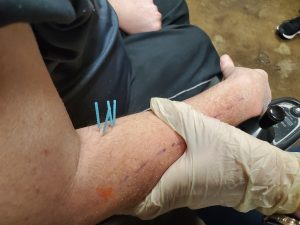
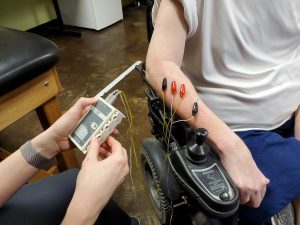
Over the past year, we have performed some dry needling to Michael’s brachioradialis muscle in his right arm, along with some dry needling to his trapezius muscles. This procedure has proven extremely effective in controlling the muscle spasms and tightness that he used to experience, and a few of these procedures also included electrical stimulation to further activate these muscles and allow for increased blood flow. Dry needling has not been necessary recently, secondary to not having any spasms in his forearm muscles or his upper trapezius muscles. Although Michael continues to have some stiffness in his cervical region, the pain in his neck has been significantly reduced since the last dry needling session several months ago and has been relieved with massaging therapy and stretching.
At our clinic, we have the great advantage of also having a massage therapist with us who helps out with transferring and treatment on weeks that we transfer Michael from his wheelchair to the therapy table. Since Michael is unable to perform many active range of motion movements, the muscles in his neck remain tight due to being stuck in the same position for most of the day. Also, since his feet are mostly in a plantarflexed position, his calves remain tight as well. Because of these issues, Michael benefits from a massage therapist working on these muscles as well to help him to sit more comfortably in his wheelchair.
Over the past several months, Michael has been practicing weight shifting and changing positioning in his chair at least once or twice an hour. This has helped to reduce soreness in Michael’s hips as well as reduce the risk of developing pressure ulcers. Another new practice that has been put into place to reduce this risk is having Michael’s caregivers inspect any problem areas more frequently. Having this done frequently can help him to get ahead on any problem areas and really stay off that area to reduce the risk of the ulcer from forming and causing problems.

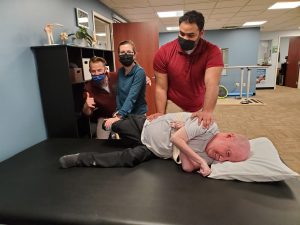
Every other week when Michael is transferred to the therapy table, we spend time stretching out his hip flexors in a side-lying position. Since Michael is in a sitting position all day, these muscles stay very tight, and in a flexed position. Getting those muscles and joints into a more extended position really helps Michael feel less discomfort in these areas. With performing these stretches every other week, Michael can now sit more comfortably in his wheelchair for about two weeks until it is time to perform them again.
Updating these topics is important to continue to discuss progress and how different techniques have continued to progress Michael’s comfort and function throughout his daily activities. All these topics have significantly affected Michael’s life. The goal of sharing all of this through these articles is to help and lend a hand where we can and to also spread the word about how physical therapy can be beneficial on many different levels. Although we discuss Michael’s care, these topics carry over into many different realms of people and their particular ailments. We will continue to progress and update different techniques and topics as they become relevant to our treatment.



